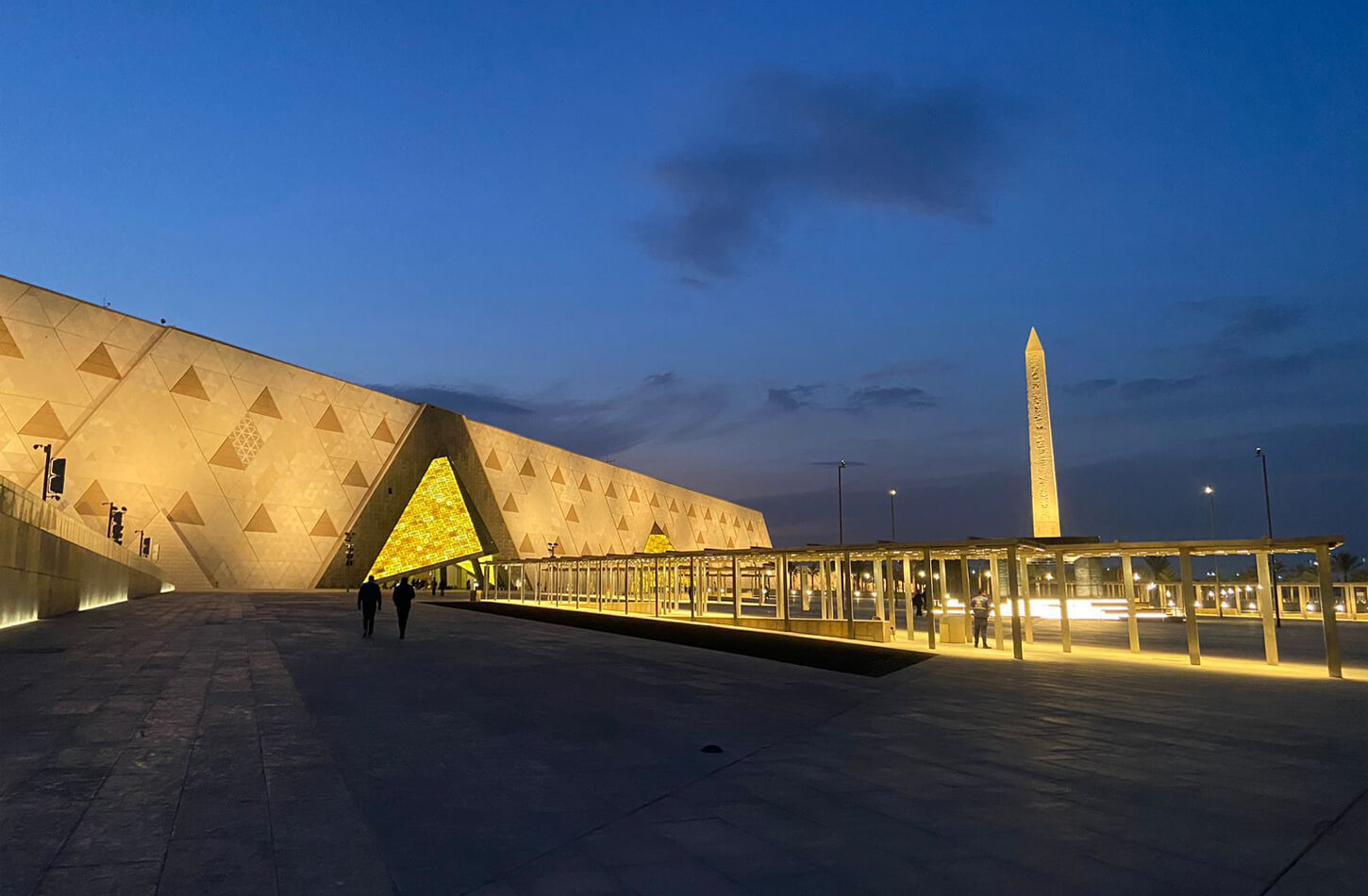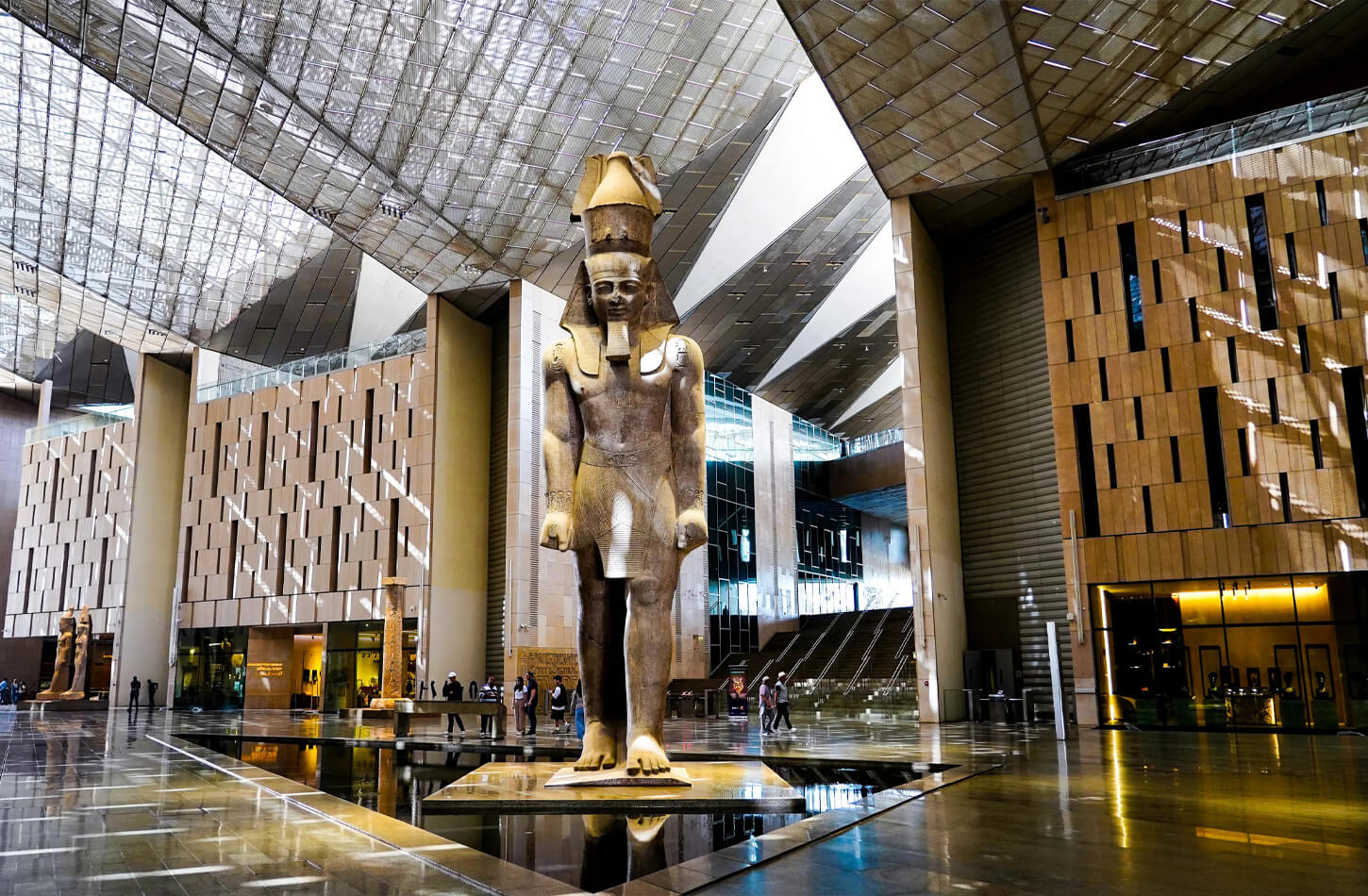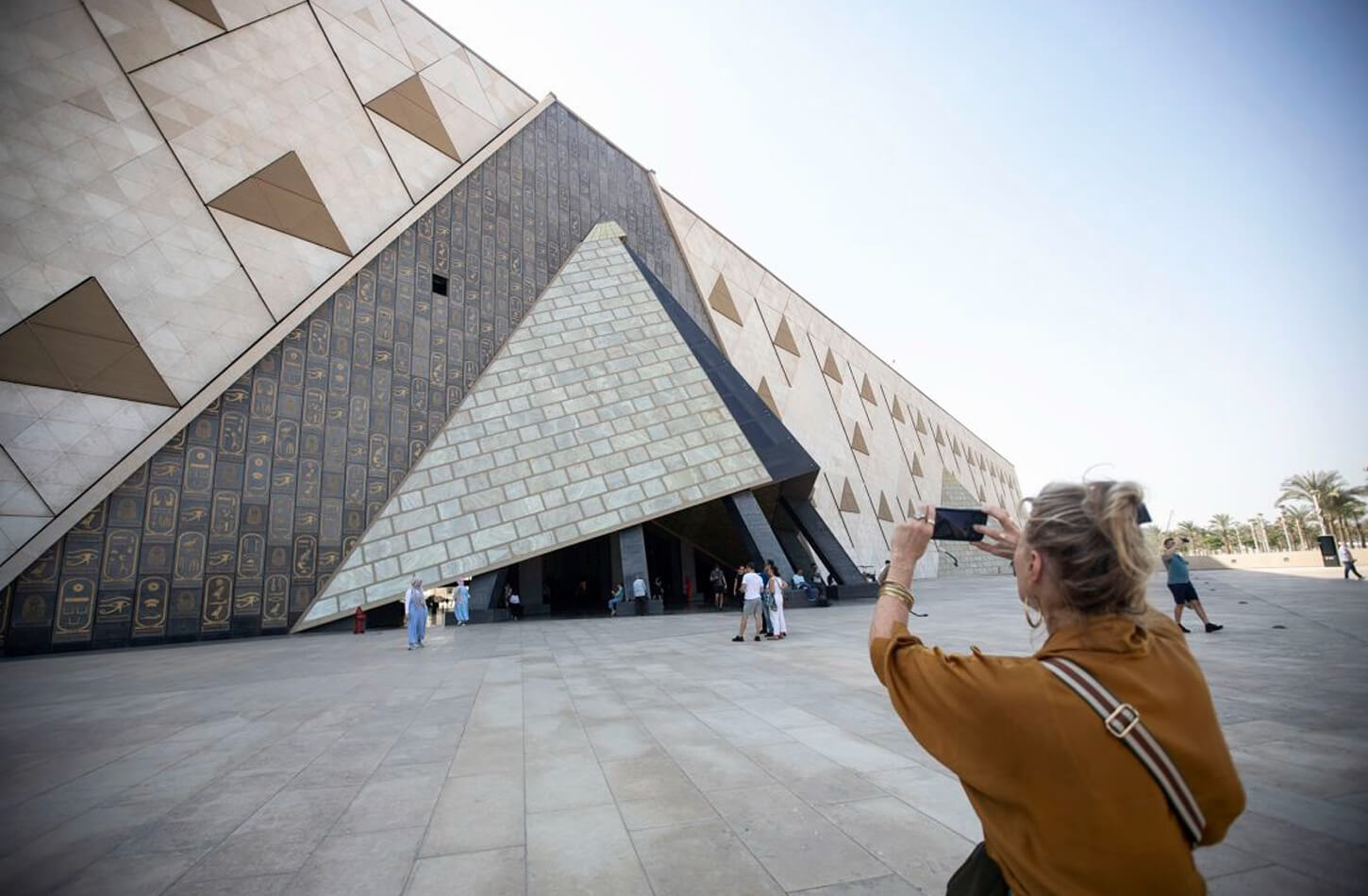You’re about to see one of the world’s biggest and newest museums. It’s near the famous Pyramids of Giza , Cairo, Egypt. This museum is full of Ancient Egypt’s history, with lots of artifacts to see. When you enter, you’ll feel like you’ve traveled back in time. The museum has the latest technology. It’s a great chance to learn about Ancient Egypt. The museum is in the middle of Giza. It’s a place you must see if you love history, archaeology, or culture. You’re going to find many amazing things.
The Birth of a Modern Wonder
The Grand Egyptian Museum’s story is one of hard work and big dreams. It started in 2005. The Irish firm Heneghan Peng Architects had a clear vision. They wanted a place that would show off Egypt’s treasures and stand out as a modern icon.
The project hit many roadblocks, including the 2008 financial crisis. This caused big delays. Then, the COVID-19 pandemic added more challenges. But, the team didn’t give up.
The museum shows what humans can achieve with determination and skill. As you learn about its history, you’ll see the meticulous planning and execution that went into it. It’s set to be a key spot for those interested in Egypt’s history and treasures. It offers a special look into the country’s past.
What Makes The Grand Egyptian Museum Special
Get ready to see one of the world’s biggest collections of Ancient artifacts at the Grand Egyptian Museum. It has over 100,000 artifacts on display. This museum is a treasure trove that will change how you see ancient civilizations.
The Tutankhamun collection is a highlight. It has over 5,000 objects from the pharaoh’s tomb. It’s one of the museum’s most valuable treasures.
The Grand Egyptian Museum is not just about its artifacts. Its architectural design is amazing. The museum’s structure shows the grandeur of ancient Egypt, with its grand halls and spacious galleries.
As you walk through, you’ll feel the history and mystery of the ancient world. It’s a truly special experience.
Located near the Pyramids of Giza, one of the Seven Wonders of the Ancient World, the Grand Egyptian Museum is a key attraction in Cairo. It lets visitors explore Egypt’s history in a modern and exciting way. The museum’s vast collection and modern facilities make it a must-see for history, archaeology, or ancient world wonders enthusiasts.

Planning Your Visit: Essential Information
To have a great time at the Grand Egyptian Museum, here’s what you need to know. It’s in Giza, near Cairo. It’s a top spot for those who love ancient Egyptian history.
The Grand Egyptian Museum tickets come in different types. You can get standard tickets, combo passes, or special ones for students and seniors. Tickets for foreigners cost a bit more, but it’s still a good deal to see such a huge museum.
The Grand Egyptian Museum opening hours are set for visitors from everywhere. It opens from 9 AM to 5 PM. Always check the official website or call the museum to confirm hours before you go.
Plan your visit with time to see everything. With over 100,000 items, you might spend a whole day here. Wear comfy shoes and drink water because you’ll be walking a lot.
The museum also has guided tours and audio guides in many languages. These can help you understand and enjoy the exhibits more. Check the prices and availability when you buy your Grand Egyptian Museum tickets.
Being ready and knowing what to expect will make your visit amazing. You’ll have a great time exploring the ancient Egyptian treasures.
Step-by-Step Guide to Navigating the Museum
To get the most out of the Grand Egyptian Museum, follow this guide. The museum has 12 exhibition halls. The Tutankhamun collection is a big highlight.
When you enter, you’ll see a grand atrium. Start your journey through the halls. The museum shows Egypt’s history with Egyptian artifacts from thousands of years.
Half-Day Visit Route
For a quick visit, start with the Tutankhamun collection. See the treasures from King Tut’s tomb. Then, check out galleries with other important artifacts from the New Kingdom period.
Full-Day Exploration Route
For a deeper dive, spend a full day. Begin with the Tutankhamun collection. Then, explore the other 11 halls. You’ll see many Egyptian history artifacts, like mummies and temple reliefs.
Choose your route wisely. Make sure to take breaks and enjoy the museum’s amenities. This guide will help you navigate the Grand Egyptian Museum well.
Experience Egypt’s Greatest Treasures at the Pyramids and Grand Egyptian Museum!
10 Must-See Treasures of King Tutankhamun
The Grand Egyptian Museum has over 5,000 artifacts from King Tutankhamun. This is a dream come true for history lovers and archaeology fans. You’ll see his famous golden death mask right away. It’s a symbol of ancient Egypt.
The museum shows many treasures found in King Tut’s tomb. You’ll see his golden funerary mask, canopic jars, and lots of jewelry. These pieces show the skill of ancient Egyptian artists.
Don’t miss the throne of Tutankhamun and his painted coffins. These items give us a peek into ancient Egypt’s culture and beliefs. They were used during the New Kingdom period.
The museum also has everyday items of King Tutankhamun. You’ll see ceremonial daggers, chariots, and fancy furniture. These items show the pharaoh’s wealth and daily life.
Exploring the Grand Egyptian Museum’s King Tutankhamun exhibit is amazing. You’ll see the huge importance of these artifacts. They remind us of King Tutankhamun’s lasting legacy and the need to protect our cultural heritage.
7 Impressive Colossal Statues You Can’t Miss
The Grand Egyptian Museum has seven colossal statues that are truly amazing. They show the grandeur and history of Egyptian history and Ancient Egypt. These statues are huge and show great skill, giving us a peek into the past.
The 36-foot-tall statue of Ramses II is one of the most impressive. It shows the king’s power and influence. This statue is a marvel of engineering and shows the ancient Egyptians’ advanced skills.
The museum also has other colossal statues, each with its own story. These statues were in temples and palaces by the Nile River. They were guardians and symbols of royal power.
When you visit the museum, you can see these statues up close. You’ll appreciate the artistry and history of these monuments. The colossal statues are a must-see for history, archaeology, or Ancient Egypt culture fans.
The Grand Egyptian Museum’s collection is full of historical treasures. The colossal statues are a big part of what makes the museum special. Visitors will be amazed by the size and beauty of these statues, leaving a lasting impression.
Exploring Egyptian Artifacts Through the Dynasties
The Grand Egyptian Museum is a treasure trove of Egyptian artifacts. It spans many dynasties, showing the details of ancient Egyptian life. You’ll see many artifacts that show how ancient Egyptians lived, their rituals, and their achievements.
Early Dynasties and the Old Kingdom: You’ll find early artifacts like pottery, jewelry, and ceremonial items. These show the start of Egyptian culture. The Old Kingdom’s collection includes big statues and tomb reliefs, showing the skill of the time.
Next, you’ll see items from the New Kingdom period. This time had powerful pharaohs and wide trade. You’ll see detailed temple reliefs, fancy furniture, and many funerary objects. These give clues about the elite’s religious and burial practices.
The museum also has a big collection from the Late Period and Ptolemaic Era. You’ll see how Egyptian art and culture mixed with foreign influences. This created a unique blend of traditions.
By looking at Egyptian artifacts through the dynasties, you’ll learn a lot about Egyptian history and archaeology. You’ll see how a civilization that still amazes us evolved.
Interactive Experiences and Technology at the Museum
At the Grand Egyptian Museum, ancient history meets modern tech. It’s a place where everyone can have fun learning. The museum uses cool tech to make history come alive.
Virtual Reality (VR) is a big part of it. It lets you step into the world of pharaohs. You’ll feel like you’re right there, exploring ancient Egypt.
The museum also has digital exhibits. You can see 3D models of artifacts and watch videos. It’s a mix of old and new that makes the New Egyptian Museum special.
Technology helps the museum share ancient Egypt with today’s world. It’s perfect for anyone interested in history. The interactive fun will make you remember ancient Egypt’s greatness.

Practical Visitor Amenities and Services
The Grand Egyptian Museum has many visitor amenities to make your visit smooth and fun. You can find several dining options, from casual spots to formal restaurants. They offer a wide range of cuisines to please everyone.
There are also comfortable lounges for you to relax. If you want to bring your own food, there are picnic areas. These features aim to make your visit unforgettable.
Buying your tickets online is easy, making entry hassle-free. Many reviews praise the museum’s efforts to make your visit enjoyable. This shows the museum’s commitment to its visitors.
The Grand Egyptian Museum is a top attraction in Cairo. It’s not just famous for its history but also for its visitor-friendly facilities. Whether you love history or just want a fun day out, the museum’s facilities are designed to ensure your comfort and enjoyment.
Photography Tips and Guidelines for American Visitors
The Grand Egyptian Museum is a goldmine for photos. It has many Egyptian artifacts for American visitors to capture. Here are some tips and guidelines to help you take the best photos.
Allowed Photography Practices: You can usually take photos in most parts of the museum. But, always be kind to others and the artifacts.
Photography Tips: For great photos, think about the lighting. Use a camera that works well in low light. Tripods are okay, but watch out for others. Flash might not be allowed in some spots, so ask the staff.
For close-up shots of artifacts, use the right lens. Also, take wide shots to show the museum’s big spaces. This adds context to your photos.
By following these tips, you’ll have a great time at the Grand Egyptian Museum. And you’ll be able to share your amazing photos with others.
5 Ways to Combine Your Visit with Other Cairo Attractions
The Grand Egyptian Museum is close to the Pyramids of Giza. This makes it easy to see more of Cairo’s sights. You can plan your day to visit other attractions too.
Visiting the Pyramids of Giza is a great idea. They are one of the Seven Wonders of the Ancient World. You can spend the morning at the museum and then see the pyramids in the afternoon. Make sure to check the Grand Egyptian Museum opening hours first.
Another fun thing to do is take a Nile River cruise. Many tours include a visit to the museum and then a cruise. This lets you see Cairo’s landmarks from a different view.
You can also see the Sphinx . They are near the Pyramids of Giza. These places give you a deeper look into ancient Egyptian history.
If you’re interested in Islamic history, visit the Cairo Islamic Heritage sites. Places like the Mosque of Muhammad Ali are a good choice. They add to your museum visit by showing Cairo’s diverse culture.
Lastly, don’t miss the Khan el-Khalili market. It’s one of the oldest bazaars in the Middle East. You can find special souvenirs and try local food, making your trip unforgettable.
Conclusion: The Legacy of Ancient Egypt Preserved
When you visit The Grand Egyptian Museum, you’re not just seeing artifacts. You’re stepping into a keeper of Ancient Egypt’s history and culture. This museum is key in saving Egypt’s legacy, making it a big cultural spot.
The Grand Egyptian Museum is more than relics. It’s an experience that makes Ancient Egypt real. With its huge collection and new tech, it lets you explore the world of pharaohs and get the story of Egyptian history.
By saving Ancient Egypt’s legacy, The Grand Egyptian Museum helps us understand and love Egyptian culture. It lets you connect with a civilization that has amazed the world for ages.


